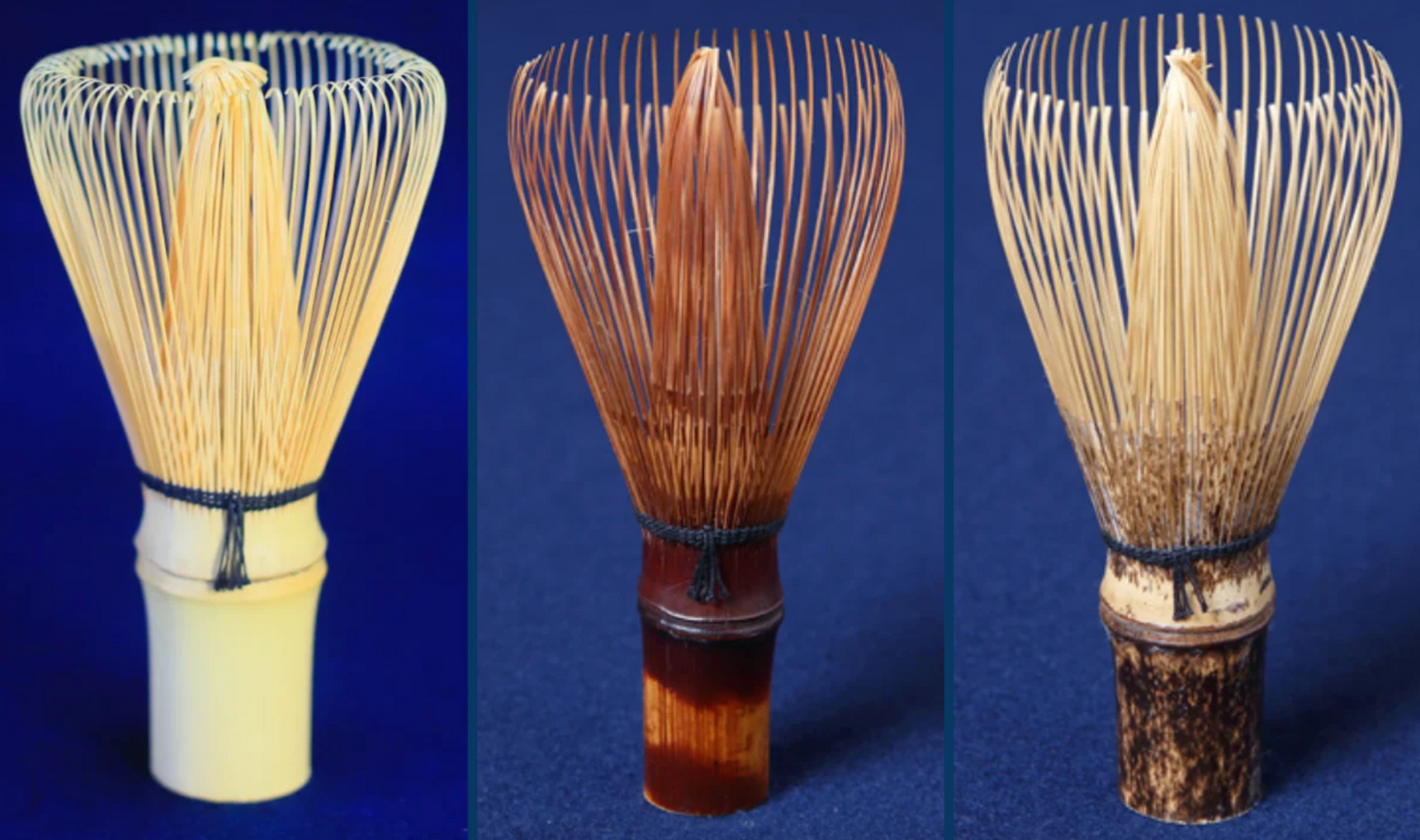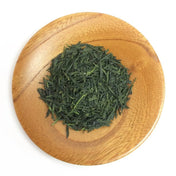Matcha is becoming known globally, with its attractive lush green color and health benifits. In Japan, the traditional tea ceremony, chado, was initiated in the early 12th century as a practice amongst the nobles. Although in Japan, chado remains very formal, internationally, matcha consumption is becoming more of a frequent household ritual for global tea connoisseurs (see, for example, a recent article on matcha consumption in Germany). Chado is simple yet rigid and highly structured with five key elements: matcha, water, chawan (tea bowl), chasen (whisk), and chashaku (tea scoop). While each of these elements serves its role, today we will focus on the chasen itself, invented in Japan about 600 years ago. Since then, there has not been much evolution. Like the chasen we see today, the very first chasen was cut from a single piece of bamboo and tied with strings at the base. In this article, we hope that we can provide you with some tips to consider when choosing a chasen.
Some things to consider when choosing a matcha whisk
Bamboo quality
As you may have guessed, the quality of the material impacts the durability of the chasen. The wide range of chasen prices that you see on the market reflects craftsmanship and also the quality and type of the bamboo that was utilized to make it. For instance, on Yunomi, the cheaper chasen are around 1700 yen, and on the high end there are chasens that cost as much as 30,000 yen ( roughly $11.00 ~ $200.00 US dollars or 10.70 ~ 190 euro).
In Japan, Takayama in Nara Prefecture has been well-known for hundreds of years for their high quality chasen. Just as there are optimal environments suited for making Japanese tea, the gentle sunshine and cool breeze of Takayama offers an optimal environment for growing firm bamboo with a nice shiny glaze. What is more, the chasen makers of Takayama will select high-quality bamboo that have been grown without the use of any chemicals or fungicides. The bamboo is then sun-dried in the winter time, then further dried in the warehouse for an additional two years! Bamboos that have been broken or bent during this time period are removed, so the bamboo that is used for making chasen are those that have been carefully selected. In fact, in the process of learning the art of chasen making, one of the first essential skills for the chasen craftsperson is to be able to select these bamboos that will end up becoming chasen.
Since I elaborated quite extensively on bamboo and the art of chasen making in a previous article, I’ll just mention one more thing. There are many different types of bamboo (e.g., white bamboo, purple/black, soot bamboo), so it is recommended that you choose one that suits your preference. If you do belong to a certain school of tea, you may be aware there are preferences like the Urasenke school using white bamboo, the Mushakojisenke using black/purple bamboo, and the Omotesenke using soot bamboo.
 There are hundreds of bamboo species in Japan, but a chasen is generally made by harvesting 3-year old bamboos in the late fall, then sun-drying them for a period of 2 months. In Takayama, Nara Prefecture, the traditional home of chasen crafting, cold curing has been a scenic winter tradition for the past 500 years. Photo by Suikaen.
There are hundreds of bamboo species in Japan, but a chasen is generally made by harvesting 3-year old bamboos in the late fall, then sun-drying them for a period of 2 months. In Takayama, Nara Prefecture, the traditional home of chasen crafting, cold curing has been a scenic winter tradition for the past 500 years. Photo by Suikaen.
One thing I do want to note is that you can also find chasen made from hygienic polypropylene resin. This is perhaps due to the fact that chasen are being utilized more outside the home, or it gives these tea ceremony tools more of a modern/casual look. The material makes these types of chasen safe, clean, and odor-free. In fact, one can even put this type of chasen in the dishwasher!
Number of tines
Tines are the “teeth,” the prongs of the chasen. While you may be more familiar with seeing chasen that have numerous tines (80~120), tine count can vary quite extensively with the minimum being about 16 tines! More tines means a chasen is more fine and delicate, contributing to a smoother matcha. It also means it’s easier to make foam, which we will elaborate on below.

Foam (This is closely related to tine count!)
Perhaps the most popular way in which people whisk their matcha is by creating foam. This is the preparation of usucha, which is the thin type of matcha (please see article referring to thin vs thick matcha). For making usucha, an ideal number of tines would be approximately 70 ~100 tines and you will find that whisks with this tine count are the most widely available on the market. In general, the curled tips of these chasen allow for the tea to be efficiently stirred to create foam. For those who are relatively new to matcha, looking for a chasen that has 80~100 tines would be a good starting point. In Japan and even overseas, one sees the kanji “百本立”, which indicates roughly 100 tines (see chasen image below).

It may be important to note that while it appears that people are always wanting to create lots of foam and believe this is the appropriate way to prepare usucha, this is the preferred style for the Urasenke tea school. Two other schools of tea, Omotesenke and Mushakojisenke schools prepare their matcha with less foam. In fact, these schools use whisks that have tines that are rather straight instead of curved, which serves the purpose to create less foam. If you are like me and personally enjoy seeing foam in your matcha bowl, it may be fun just to mix it up occasionally to try a matcha without much foam. Some people think that without the foam, one is able to better access the umami and shibumi (bitterness) of the matcha.
Chasen for Thick Tea
We mentioned usucha (thin tea) earlier which means that there is an opposite, koicha, thick tea. Koicha has a thickness that is almost like a thick soup or a gravy sauce. The thickness is due to having 2-3 times the amount of matcha and less water in comparison to usucha. If you are someone who regularly prepares thick tea, you may want to invest in a matcha whisk that is specifically suited for making koicha. These whisks have tines that are rather rough and more durable, appropriate for when whisking (sometimes called kneading) the koicha. In addition, due to the fact that koicha has a thicker consistency, an ideal whisk for thick tea would be one with less tines, perhaps 16 ~ 48. With respect to durability, a whisk with purple/black bamboo could be beneficial for those who enjoy making thick tea. Purple/black bamboo is the most heavy-duty and high density material for making a matcha whisk. These types of whisks can last 3 times longer than a regular white bamboo chasen.
Made in Japan or elsewhere?
Chasen made in Japan are more supple and durable even though they tend to be more expensive in comparison to foreign-made chasen. For someone who is new to matcha, it may actually be difficult to tell the difference between domestic and foreign chasen. Yet, for those who have gained some experience and can feel the sensation of the tips of the chasen, those made in Japan are recommended. As mentioned earlier, “Takayama Chasen” made in Takayama, Nara Prefecture (where Suikaen is located) is a famous place when it comes to chasen. In fact, 90% of Japanese chasen are still produced in Takayama today. The beautiful craftsmanship that goes into one chasen is quite stunning! That being said, it is also completely okay to use a chasen that is not made in Japan. Many chasen from overseas in Japan are made in China and they can be purchased at relatively reasonable prices. These chasen are easy to use, very accessible for those who are relatively new to the way of tea.
Still unsure about what type of chasen to choose?
Some final words about selecting a good chasen. Remember that if you are a regular matcha drinker, you will be using your chasen quite frequently so it’s important that you like it and it suits your preference! Suikaen’s chasen may be a bit more pricey than what you are used to, but it reflects all of the beautiful craftsmanship that goes into one chasen. Furthermore, some of their chasen have a personal touch - such as rainbow string or a more mellower - green/blue color to invite peace and calm. It can be fun to imagine what matcha bowl you will pair it with, what season it may be appropriate for, or simply what your personal style is. Oh, and of course, it could be a very nice gift for a special someone!
Below, I provide just a few suggestions for matching chasen with a matcha bowl for inspiration:
 Perhaps this calming combination is more appropriate for the summer months. Chasen from Suikaen, Refreshing (Ryo, 涼) and matcha bowl by Yamaki Ikai, Deep sea blue-green matcha tea bowl.
Perhaps this calming combination is more appropriate for the summer months. Chasen from Suikaen, Refreshing (Ryo, 涼) and matcha bowl by Yamaki Ikai, Deep sea blue-green matcha tea bowl.
 Kizoku Club’s black tenmoku nagashi matcha bowl paired with Suikaen’s Shichiku Purple Bamboo Shin Chasen Matcha Whisk.
Kizoku Club’s black tenmoku nagashi matcha bowl paired with Suikaen’s Shichiku Purple Bamboo Shin Chasen Matcha Whisk.
Related articles:
- Bamboo and the art of chasen making
- Discover Koicha, the thick matcha of formal Japanese tea ceremonies
- Matcha is becoming hip in Germany, here's why
- Tea Ceremony Politics
Featured image: Suikaen’s chasens depicting the different types of bamboo that are utilized. From left to right: white, susudake, and kurotake/purple chasen.


